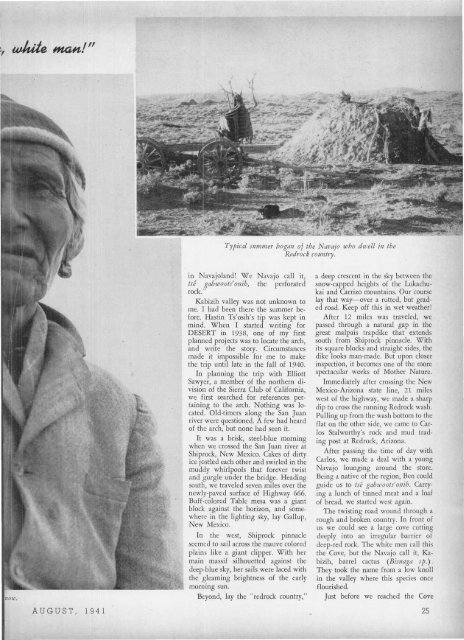THE M A G A Z I N E - Desert Magazine of the Southwest
THE M A G A Z I N E - Desert Magazine of the Southwest
THE M A G A Z I N E - Desert Magazine of the Southwest
Create successful ePaper yourself
Turn your PDF publications into a flip-book with our unique Google optimized e-Paper software.
\r w-kite man!"<br />
AUGUST, 1941<br />
Typical summer hogan o\ <strong>the</strong> Navajo who dwell in <strong>the</strong><br />
Redrock country.<br />
in Navajoland! We Navajo call it,<br />
tse gahxvoots'onih, <strong>the</strong> perforated<br />
rock."<br />
Kabizih valley was not unknown to<br />
me. I had been <strong>the</strong>re <strong>the</strong> summer before.<br />
Hastin Ts'osih's tip was kept in<br />
mind. When I started writing for<br />
DESERT in 1938, one <strong>of</strong> my first<br />
planned projects was to locate <strong>the</strong> arch,<br />
and write <strong>the</strong> story. Circumstances<br />
made it impossible for me to make<br />
<strong>the</strong> trip until late in <strong>the</strong> fall <strong>of</strong> 1940.<br />
In planning <strong>the</strong> trip with Elliott<br />
Sawyer, a member <strong>of</strong> <strong>the</strong> nor<strong>the</strong>rn division<br />
<strong>of</strong> <strong>the</strong> Sierra Club <strong>of</strong> California,<br />
we first searched for references pertaining<br />
to <strong>the</strong> arch. Nothing was located.<br />
Old-timers along <strong>the</strong> San Juan<br />
river were questioned. A few had heard<br />
<strong>of</strong> <strong>the</strong> arch, but none had seen it.<br />
It was a brisk, steel-blue morning<br />
when we crossed <strong>the</strong> San Juan river at<br />
Shiprock, New Mexico. Cakes <strong>of</strong> dirty<br />
ice jostled each o<strong>the</strong>r and swirled in <strong>the</strong><br />
muddy whirlpools that forever twist<br />
and gurgle under <strong>the</strong> bridge. Heading<br />
south, we traveled seven miles over <strong>the</strong><br />
newly-paved surface <strong>of</strong> Highway 666.<br />
Buff-colored Table mesa was a giant<br />
block against <strong>the</strong> horizon, and somewhere<br />
in <strong>the</strong> lighting sky, lay Gallup,<br />
New Mexico.<br />
In <strong>the</strong> west, Shiprock pinnacle<br />
seemed to sail across <strong>the</strong> mauve colored<br />
plains like a giant clipper. With her<br />
main massif silhouetted against <strong>the</strong><br />
deep-blue sky, her sails were laced with<br />
<strong>the</strong> gleaming brightness <strong>of</strong> <strong>the</strong> early<br />
morning sun.<br />
Beyond, lay <strong>the</strong> "redrock country,"<br />
a deep crescent in <strong>the</strong> sky between <strong>the</strong><br />
snow-capped heights <strong>of</strong> <strong>the</strong> Lukachukai<br />
and Carrizo mountains. Our course<br />
lay that way—over a rutted, but graded<br />
road. Keep <strong>of</strong>f this in wet wea<strong>the</strong>r!<br />
After 12 miles was traveled, we<br />
passed through a natural gap in <strong>the</strong><br />
great malpais trapdike that extends<br />
south from Shiprock pinnacle. With<br />
its square blocks and straight sides, <strong>the</strong><br />
dike looks man-made. But upon closer<br />
inspection, it becomes one <strong>of</strong> <strong>the</strong> more<br />
spectacular works <strong>of</strong> Mo<strong>the</strong>r Nature.<br />
Immediately after crossing <strong>the</strong> New<br />
Mexico-Arizona state line, 21 miles<br />
west <strong>of</strong> <strong>the</strong> highway, we made a sharp<br />
dip to cross <strong>the</strong> running Redrock wash.<br />
Pulling up from <strong>the</strong> wash bottom to <strong>the</strong><br />
flat on <strong>the</strong> o<strong>the</strong>r side, we came to Carlos<br />
Stalworthy's rock and mud trading<br />
post at Redrock, Arizona.<br />
After passing <strong>the</strong> time <strong>of</strong> day with<br />
Carlos, we made a deal with a young<br />
Navajo lounging around <strong>the</strong> store.<br />
Being a native <strong>of</strong> <strong>the</strong> region, Ben could<br />
guide us to tse gahivoots'onih. Carrying<br />
a lunch <strong>of</strong> tinned meat and a loaf<br />
<strong>of</strong> bread, we started west again.<br />
The twisting road wound through a<br />
rough and broken country. In front <strong>of</strong><br />
us we could see a large cove cutting<br />
deeply into an irregular barrier <strong>of</strong><br />
deep-red rock. The white men call this<br />
<strong>the</strong> Cove, but <strong>the</strong> Navajo call it, Kabizih,<br />
barrel cactus (Bisnaga sp.).<br />
They took <strong>the</strong> name from a low knoll<br />
in <strong>the</strong> valley where this species once<br />
flourished.<br />
Just before we reached <strong>the</strong> Cove<br />
25

















